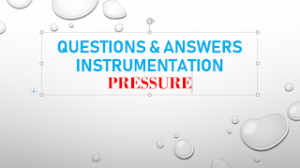QUESTIONS AND ANSWERS LEVEL INSTRUMENTATION
What is the definition for the term level as it applies to process measurement?
- Level refers to the amount of space occupied by an object or fluid in a tank. It can also be used
to express the capacity of a container
- Level is defined as the amount of force applied by a pressurized fluid on each unit area of its
container
- Level is defined as the position between phases, where the phases liquid/gas, solid/gas, or immiscible liquid/liquid.
- Level refers to the measure of the internal molecular activity of a substance
What should you consider when selecting a level measurement device?
- Physical properties of the process materials only
- Chemical properties of the process materials only
- Both the physical and chemical properties of the process materials
- A point measurement system or a continuous measurement system only
What are the two types of level measurement?
- Continuous and point
- Point and intermediate
- Intermediate and point
- Range and specific point
What is the definition of level as it applies to the measurement of process variables?
- The horizontal distance between the interface and one or more specific points
- The vertical distance between the interface and one or more specific points
- The horizontal distance between the interface and the flow over point
- The total distance gained or lost by the process material gage
Two important types of level measurement are:
- Point and intermediate
- Intermediate and point
- Continuous and point
- Range and specific point
Level, as it applies to the measurement of process variables, is defined as:
- The horizontal distance between the interface and one or more specific points
- The horizontal distance between the interface and the flow over point
- The total distance gained or lost by the process material gage
- The vertical distance between the interface and one or more specific points
Which of the following objectives must be defined when selecting a level measuring instrument?
- Remote versus local
- Standard versus defined
- Open versus sealed
- Primary versus secondary
What are two ways a level measuring device uses to detect the location of the interface?
- Estimated and gaged
- Direct and inferential
- Indirect and direct
- Inferential and estimated
Before selecting a level measuring device, you must:
- Obtain instrument documentation
- Outline the entire process
- Define measurement objectives
- Examine surrounding environment
Which properties must be considered when selecting a level measuring device?
- Characteristics of the environment surrounding the process only
- Chemical properties of the process material only
- Physical properties of the process material only
- Both physical and chemical properties of the process material
Which measuring device would you use if you were measuring a highly viscous processed liquid?
- Sight glass
- Plastic tube
- Float
- Dipstick
In a float device which component indicates the level of the substance on the scale plate?
- Float ring
- Collar magnet
- Switch magnet
- Follower
Which of the following level measuring devices is weighted at one end to ensure vertical insertion?
- Steel tape
- Sight glass
- Dipstick
- Float
What is considered the simplest direct method of measuring process level?
- Audible
- Visual
- Mechanical
- Electrical
Which of the following devices consists of a length of rigid material with graduated lines?
- Steel tape
- Sight glass
- Dipstick
- Float
The simplest direct method of measuring process level is by:
- Audible alert
- Mechanical detection
- Electrical detection and signal
- Sight
Crude level measurement of granular solids or highly viscous process liquids can be obtained with a:
- Dipstick
- Sight glass
- Float
- Steel tape
Which level measuring device can be used for crude level measurement of granular solids or highly viscous process liquids?
- Steel tape
- Dipstick
- Sight glass
- Float
Each of the following are limitations to the dipstick or steel tape devices EXCEPT:
- Cannot be used in processes that require pressure or temperature control
- Cannot be used for toxic or corrosive gases
- Cannot be used with process materials other than liquids
- Requires an open process container for insertion
Which measuring device would you use if you were measuring the level container of granular solids?
- Steel tape
- Float
- Sight glass
- Dipstick
Which level measuring device operates on the principle that liquid seeks the same level when equal Pressure is exerted on the surface of two connected columns?
- Sight glass
- Dip gage
- Float cylinder
- Float tube
Which level measuring device is used in closed, low-pressure systems?
- Dip gage
- Sight glass
- Steel tape
- Dipstick
A device installed with service valves that allow it to be isolated from the process is called a:
- Dip tube
- Float tube
- Sight glass
- Ball-check tube
What type of device operates on the principle that liquid seeks the same level when equal pressure is exerted on the surfaces of two connected columns?
- Steel tape
- Dipstick
- Float
- Sight glass
Using a sight glass to measure level involves a risk of:
- Glass breakage
- Inaccurate level readings
- Overheating
- Process product evaporation
Sight glass devices should be installed:
- In a hidden location
- Where risk of breakage is small
- At a 45 degree angle for ease of viewing
- At or near the top of the process container
What risk is involved when using a sight glass to measure level in a process container?
- Inaccurate level readings
- Overheating
- Glass breakage
- Process product evaporation







